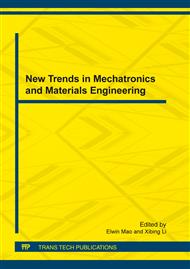[1]
J. van der Geer, J.A.J. Hanraads, R.A. Lupton, The art of writing a scientific article, J. Sci. Commun. 163 (2000) 51-59.
Google Scholar
[1]
Sun X, Zhang J Y, Gui W W., Development Trend and Market Demand of Electrical Cable Materials Industry in China, Plast. Sci. Techn. 6 (2009) 83-86.
Google Scholar
[2]
Goto T, Yamashita M, Sakamaki M., Development of Y-branch joint for 275-kV XLPE and fluid-filled cable, Elect. Eng. Japan. 164 (2008) 18-24.
DOI: 10.1002/eej.20514
Google Scholar
[3]
Naskar K, Mohanty S, Nando G B., Development of thin-walled halogen-free cable insulation and halogen-free fire-resistant low-smoke cable-sheathing compounds based on polyolefin elastomer and ethylene vinyl acetate blends, J. Appl. Polym. Sci., 104 (2007).
DOI: 10.1002/app.25870
Google Scholar
[4]
Hsu Y T, Chang-Liao K S, Wang T K, Kuo C T., Monitoring the moisture-related degradation of ethylene propylene rubber cable by electrical and SEM methods, Polym. Degra. Stab., 91 (2006) 2357- 2364.
DOI: 10.1016/j.polymdegradstab.2006.04.003
Google Scholar
[5]
Hwang I, Lee J S, Spencer B F., Isolation System for Vibration Control of Stay Cables, J. Eng. Mech., 135 (2009) 62-66.
DOI: 10.1061/(asce)0733-9399(2009)135:1(62)
Google Scholar
[6]
Milani G, Milani F., Genetic algorithm for the optimization of rubber insulated high voltage power cables production lines, Compu. Chem. Eng., 32 (2008)3198- 3212.
DOI: 10.1016/j.compchemeng.2008.05.010
Google Scholar
[7]
Anandakumaran K., IEEE Aging and Condition Monitoring Studies of Composite Insulation Cables Used in Nuclear Power Plants, Trans. Dielect. Electr. Insulation, 14 (2007) 227-237.
DOI: 10.1109/tdei.2007.302891
Google Scholar
[8]
Yang Y Q, Wei G, Duan H J, Feng Y C., Research Progress on Halegen-free Flame-retardant PE Cable Materials, Plast. Sci. Techn., 36 (2008) 84-88.
Google Scholar
[9]
Li Z A., Ethylene-propylene Copolymer based Compound for Electric Cable Insulation: A Rheological and Processability Study, Rubb. Plast. Resour. Utili., (2009) 23-31.
Google Scholar
[10]
Wang Y S., The prepared method of EPR cable materials with radiation resistant, low smoking and halogen-free flame retardant, China Rubber Science and Technology Market, (2009)17.
Google Scholar
[11]
Li T, Zhang L Q., Study on Application of EPDM and prepared of novel blend, Beijing Uni. Chem. Technol., (2006) 13-27.
Google Scholar
[12]
Xiong L M, Li L., Study on The Formulation Design and Applied Properties of EPDM/CPE Blends, Nanchang Hangkong University, (2008) 11-64.
Google Scholar


